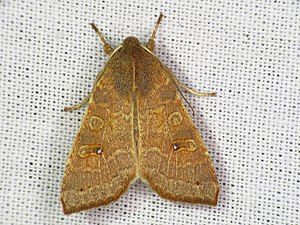Poplar yellow owl
| Poplar yellow owl | ||||||||||||
|---|---|---|---|---|---|---|---|---|---|---|---|---|

Poplar yellow owl ( Cirrhia ocellaris ), yellow-brown color variant |
||||||||||||
| Systematics | ||||||||||||
|
||||||||||||
| Scientific name | ||||||||||||
| Cirrhia ocellaris | ||||||||||||
| ( Borkhausen , 1792) |
The poplar yellow owl ( Cirrhia ocellaris ), sometimes to be found in the literature as Xanthia ocellaris , is a butterfly from the family of the owl butterflies (Noctuidae). The specific epithet is derived from the Latin word ocellus , meaning "little eye" and refers to the small eye spots within the kidney defects .
features
butterfly
The wingspan of the moth is 33 to 40 millimeters. They are variable in color. Yellow-brown, gray-brown or reddish-brown specimens appear. Most of the drawing is pale. The apex is pointed forward. The transverse lines on the upper side of the forewing are doubled and filled with yellow. Ring and kidney defects are outlined in brown. A small white eye-spot usually stands out within the kidney defects. The upper side of the hind wing is colored whitish without drawing.
Caterpillar
The caterpillars are gray-brown to red-brown in color. The back and side back lines stand out faintly bright. The head is light brown, the neck plate is dark brown.
Similar species
The elm yellow owl ( Cirrhia gilvago ) is similar in color and drawing, but differs in its rounder apex. In addition, the small eye spot within the kidney defects is mostly black in color.
distribution and habitat
The distribution of the poplar yellow owl extends through central Europe to Siberia . It is also found in Asia Minor and Kazakhstan, as well as Lebanon and Iraq . There is another occurrence area in northwest Africa. Habitat are river valleys, floodplains, poplar avenues, urban areas as well as gardens and parks.
Way of life
The moths fly from late August to late October. They are nocturnal and appear on artificial light sources and baits . The species overwinters in the egg stage. The caterpillars live from March to June. Young caterpillars initially feed on the catkins of poplar species ( Populus ). The Canadian poplar ( Populus × canadensis ) is preferred . Another food plant is the black poplar ( Populus nigra ). Older caterpillars drop to the ground with the dead catkins and then feed on low plants. Good results have been achieved in breeding with dandelions .
Danger
The species occurs in different numbers in Germany. In the eastern federal states it is classified as “not endangered” on the red list of endangered species . In Baden-Württemberg , Bavaria and North Rhine-Westphalia , on the other hand, it is "on the pre-warning list".
Individual evidence
- ^ Arnold Spuler: The butterflies of Europe . tape 1 . E. Schweitzerbartsche Verlagbuchhandlung, Stuttgart 1908, p. 253 .
- ↑ László Ronkay, José Luis Yela, Márton Hreblay: Hadeninae II. - Noctuidae Europaeae, Volume 5. , Sorø, 2001, ISBN 87-89430-06-9 , pp. 67/68
- ↑ Walter Forster, Theodor A. Wohlfahrt: The butterflies of Central Europe. Volume 4: Owls. (Noctuidae). Franckh'sche Verlagshandlung, Stuttgart 1971, ISBN 3-440-03752-5 , p. 223
- ↑ a b Günter Ebert (Ed.): The butterflies of Baden-Württemberg. 1st edition. Volume 6. Moths IV. Noctuidae 2nd part. Ulmer, Stuttgart (Hohenheim) 1997, ISBN 3-8001-3482-9 , pp. 427-430
- ↑ Markku Savela: distribution. In: Lepidoptera and some other life forms. Accessed January 20, 2020 (English).
- ^ Karl Cleve: The butterflies of West Berlin , Berliner Naturschutzblätter, Volksbund Naturschutz e. V., Volume 21, No. 61, 1977, pp. 307/308
- ↑ Manfred Koch: We identify butterflies. Volume 3: Owls. 2nd, expanded edition. , Neumann Verlag, Leipzig / Radebeul, 1972, pp. 158/159
- ↑ Arno Bergmann: The large butterflies of Central Germany. Volume 4/1: Owls. Distribution, forms and communities. Urania-Verlag, Jena 1954, pp. 561-564
- ↑ Federal Agency for Nature Conservation (Ed.): Red List of Endangered Animals in Germany. , Landwirtschaftsverlag, Münster, 1998, ISBN 3-89624-110-9
literature
- László Ronkay, José Luis Yela, Márton Hreblay: Hadeninae II. - Noctuidae Europaeae, Volume 5. , Sorø, 2001, ISBN 87-89430-06-9
- Günter Ebert (Ed.): The butterflies of Baden-Württemberg. 1st edition. Volume 6. Moths IV. Noctuidae 2nd part. Ulmer, Stuttgart (Hohenheim) 1997, ISBN 3-8001-3482-9
- Walter Forster, Theodor A. Wohlfahrt: The butterflies of Central Europe. Volume 4: Owls. (Noctuidae). Franckh'sche Verlagshandlung, Stuttgart 1971, ISBN 3-440-03752-5
Web links
- Lepiforum eV - taxonomy and photos
- www.schmetterlinge-deutschlands.de - endangerment
- ukmoths - UKMoths
